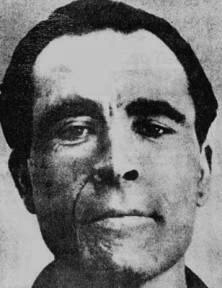Ramon Vila Capdevila facts for kids
Quick facts for kids
Ramon Vila Capdevila
|
|
|---|---|

Ramon Vila Capdevila
|
|
| Born | 2 April 1908 |
| Died | 7 August 1963 (aged 55) |
| Cause of death | Gunshot wounds |
| Nationality | Spanish |
| Other names | Caracremada (burnt-face); Jabala (wild boar); Pasos Largos (long steps); |
| Organization | Confederación Nacional del Trabajo |
| Known for | Anarchist insurgent |
| Movement | Anarchism |
Ramon Vila Capdevila (born April 2, 1908 – died August 7, 1963) was a brave fighter from Catalonia, Spain. People knew him by nicknames like Caracremada (which means "burnt-face" in Catalan). He was a member of the Confederación Nacional del Trabajo (National Confederation of Labor), a group that believed in Anarchism. Ramon Vila Capdevila was also a guerrilla fighter, someone who fought against a government or army using surprise attacks.
Ramon Vila Capdevila's Early Life
Ramon Vila was born in 1908 in a small village called Peguera. This village is in the Berguedà area of Catalonia. When he was very young, a lightning bolt almost hit him. This accident caused scars on his face, which is how he got the nickname Caracremada. Sadly, the lightning strike also killed his mother, who was hiding with him from the storm.
In 1932, Ramon Vila took part in a workers' protest. Because of this, he was put in prison in Manresa for a few years. After he was released, he moved around a lot. He was worried about being bothered by a special police group.
In April 1936, while Ramon Vila was in Castelló de la Plana, two police officers approached him. There was a shooting, and Ramon Vila's cousin was hurt. The two officers were also injured, and one of them died. Ramon Vila ran away but later turned himself in to the Guardia Civil. He hoped they would treat him better than the special police group.
On July 18, 1936, after a big uprising, prisons were opened to find more fighters. Ramon Vila was set free and joined the fight. He later became a leader in the Carabinero Corps. He also helped manage supplies at the factory where he worked in Fígols.
Fighting After the Civil War
After the Spanish Civil War ended in 1939, Ramon Vila went to France. He was held in a camp in Argelès-sur-Mer. However, the next year, he escaped and went back to Spain. There, he started a secret resistance group.
Soon after, Ramon Vila went back to France to get supplies. He was arrested by Germans, who were controlling France at that time. He was put in prison in Perpignan. But he was only there for a short time before the Germans sent him to work in a mine.
He soon joined the French Resistance, a group that fought against the German occupation. Ramon Vila was good with explosives and used his skills to damage enemy property. His group later joined the Free French Forces, led by General Philippe Leclerc de Hauteclocque.
After World War II ended, Ramon Vila mostly worked in the Catalan areas of Alt Llobregat and Baix Llobregat. As his last act of resistance, he destroyed some radio towers on August 2, 1963, near Manresa.
Ramon Vila's Death
On August 7, 1963, Ramon Vila was near a castle in Balsareny. Three Guardia Civil officers found him. When they called out to him, Ramon Vila fired his weapon. The officers fired back, and he was shot in the heart. No police officers were hurt. The official news about his death called Ramon Vila a "bandit."
Ramon Vila was buried in Fígols. On July 15, 2000, a special plaque was placed at his burial site. It says:
Here lie the remains of Ramon Vila Capdevila. He was a fighter for the CNT and the last of the Catalan anarchist maquis. He was part of the declaration of libertarian communism (1932), the civil war (1936-39), and the French Resistance (1939-45). For 18 more years, he fought against Francoism. This is in memory of him and all who gave their lives for freedom and the anarchist idea.
—Castellnou, The Libertarian Movement, 15 July 2000
Sources

